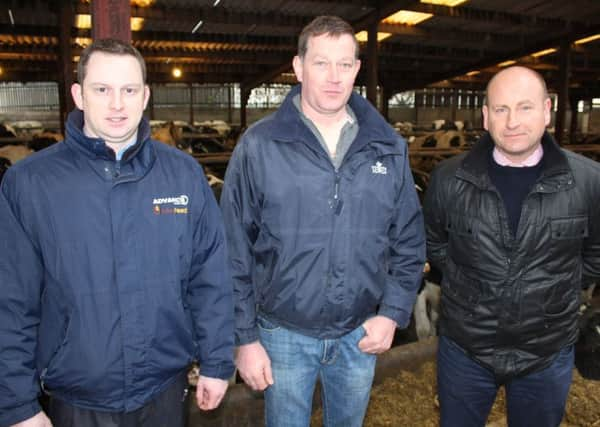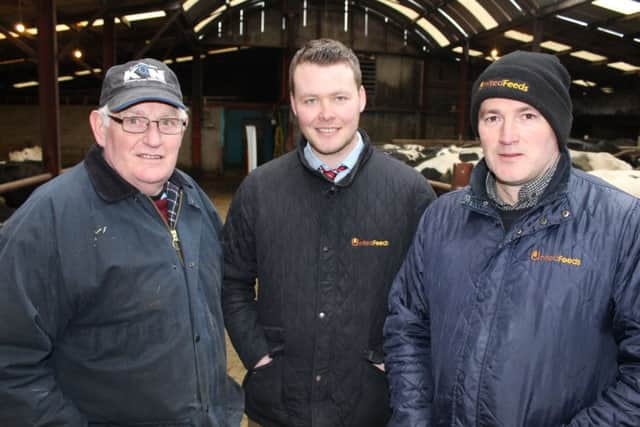Focus on protein at Moneymore dairy workshop


This was the focus of a recent workshop hosted by Moneymore milk producer Steven Browne, who farms with his father Alex.
They milk 240 cows, with a year-round calving pattern. Annual yields are in the region of 10,000l.
Advertisement
Advertisement
A Dale Farm director, Steven was involved in the original trial work carried out by United Feeds on milk protein enhancement.


Optimising cheese yields from the milk supplied to Dale Farm was the driver for the work.
But so impressed were Steven and Alex with the results of the trial that they committed to procuring the protein enhancer rations on an ongoing basis.
United Feeds’ nutritionist Bobby Irwin was one of four speakers at the workshop.
Advertisement
Advertisement
He said that a number of objectives had been set regarding United Feeds involvement with the Browne herd.


He said: “These include the consistent lifting of milk protein levels plus an improvement in herd fertility and herd health. We also committed to look at ways of lowering the total protein values of the diets fed to the cows in an effort to reduce cost and maximise efficiency.
“All of this was undertaken on the basis that the nutritional changes made would not impact on individual cow yields.
“And we have succeeded in achieving these aims. In November 2015 the cows were averaging 28L at 3.14% protein.
“The equivalent protein figure today is 3.31%.”
Advertisement
Advertisement
Bobby confirmed that the improvement in milk quality had been achieved while feeding diets containing less crude protein than would have previously been the case on the Browne farm.
“Feeding excessive levels of dietary protein is wasteful, from many points of view,” he said.
“This approach results in significant quantities of an expensive input being converted to urea in the cows and then excreted in the form of ammonia. This process alone puts strain on the cow and reduces the overall efficiency of the feeding process.”
But the United Feeds’ nutritionist also confirmed that feeding a more balanced ration, from a protein point of view, is also important.
And this entails an assessment of its Amino Acid make up.
Advertisement
Advertisement
This was a specific point discussed by Kemin’s Andrew Armstrong.
“Methionine is the first limiting Amino Acid in dairy cow diets,” he said.
“Significantly, it has been identified as one of the most limiting amino acids for the synthesis of milk and milk protein by dairy cows fed high forage diets.
“One approach that has been used to supply additional methionine to cows has been to protect it from ruminal degradation for subsequent absorption from the small intestine.
Advertisement
Advertisement
“The work carried out by the team at United Feeds has confirmed that the inclusion of protected methionine will lift milk protein yields.”
Brett Wesley, from Advanced Fertilizers, also spoke at the workshop. He advised attending farmers that soil testing results must dictate their fertiliser spreading policies.
“Lime is one of the most undervalued farm inputs in Northern Ireland.
“A very high proportion of grassland soils in Northern Ireland are too acidic. By lifting the pH, soil potash and phosphorous availability will increase almost immediately.”
Advertisement
Advertisement
Brett also discussed the benefits of Advanced Fertilizer’s Koch Advanced Nitrogen (KaN) range.
“At the heart of the manufacturing process is the application of a new technology. In essence, an innovative coating process covers each individual fertiliser granule with a film of Agrotain. Agrotain is a nitrogen stabiliser which acts to inhibit the action of the enzyme urease, which is found in many types of soil bacteria.
“It is urease which acts to break down soil applied urea into ammonia, which then escapes to the atmosphere. As a consequence, the impact which untreated urea fertilisers can have on plant growth is greatly diminished as soil temperatures increase. KaN has been proven time and time again to perform at least as well as CAN based fertilisers in Northern Ireland and is available in a range of N,P,K and So3 combinations.
“The starting point to the process is our sourcing of extremely high quality urea, all of which is pre-dusted before the coating process takes place. The end result is a range of Koch Advanced Nitrogen based fertilisers that can be used effectively throughout the growing season under Northern Ireland conditions.”
Advertisement
Advertisement
The final speaker at the workshop was CAFRE’s Dr David Mackey. He confirmed that heat detection rates are traditionally higher in exclusively spring calving herds than on units where cows are calving the year round.
“Partly, this is because farmers are dealing with larger groups of animals within the breeding group. So it is that bit easier to pick up on bulling behaviour,” he said
Dr Mackey explained that the degree of negative energy balance that dairy cows encounter post-calving will impact on her subsequent fertility.
“Normally, the cow will want to come back into heat between 15 and 20 days after calving. But a prolonged period of negative energy balance could put this out to 42 days.
Advertisement
Advertisement
“There is evidence to show that over conditioned cows prior to calving will experience longer periods of negative energy balance.”
Dr Mackey said that fertility performance is a major driver regarding the profitability levels recorded by milk producers in Northern Ireland. He points out that the average cost of infertility is approximately £217 per cow, across all production patterns: spring, autumn and year-round calving. This figure is based on a cow giving 7,000l of milk, priced at 22p/l.
“Breeding also has a direct bearing on milk output and quality,” he said.
“Genetics accounts for 35% of the variation in third lactation corrected 305-day milk yield within a herd.
Advertisement
Advertisement
“However, breeding policy accounts for 53% of the variation in lactation average butterfat percentage. The equivalent figure for milk protein is 46%.”
David said that improving milk quality does pay. If improvements in the order of 0.1% butterfat and 0.1% protein can be achieved within a herd of cows averaging 7,500l. This is the equivalent of getting an extra 1,230l/cow at base price equivalent with milk priced at 22p/l.”
If you would like to discuss the feeding policy of your herd contact your local United Feeds adviser or Customer Services on 028 9075 9000.